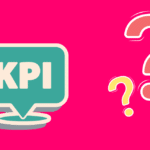In the world of digital marketing, KPI is a term you’re bound to come across. Short for Key Performance Indicator, KPIs are a fundamental component of any marketing strategy. T
These metrics are used to evaluate the success of marketing campaigns, and help marketers make informed decisions about future strategies.
KPIs are quantifiable measurements that reflect the critical success factors of a business. They are used to evaluate the performance of an organization and to identify areas that may need improvement. In the context of digital marketing, KPIs are essential to tracking the effectiveness of online marketing efforts and understanding their impact on a company’s bottom line.
In this article, we’ll take an in-depth look at KPIs, focusing on their importance in digital marketing.
We’ll also cover a range of topics, from what KPIs are, and the difference between KPIs and metrics, to the various types of KPIs you can use in your digital marketing campaigns.
Then we delve into how to set up and track KPIs, and how to use KPIs to improve your digital marketing strategies.
Let’s rock and roll marketers!
What is a KPI in Digital Marketing?

Key Performance Indicators (KPIs) are specific, measurable values that demonstrate how effectively a company is achieving its key objectives.
These KPIs can be tailored to evaluate success in different areas of an organization, such as marketing, sales, and customer service.
In digital marketing, KPIs serve as a crucial tool to help you track your success. It’s a way to measure your performance against your digital marketing objectives. These objectives could be things like brand awareness, lead generation, or revenue growth.
By tracking KPIs, you’ll be able to see what’s working and what’s not. This information can help you make better decisions about your marketing strategies.
What is the Difference Between KPIs and Metrics?

The terms KPIs and metrics are often used interchangeably, but they have different meanings and serve different purposes.
Let’s clarify the difference.
- Key Performance Indicators (KPIs): These are specific and measurable values that demonstrate how effectively an organization is achieving its key objectives. KPIs are high-level indicators that are crucial for assessing the performance and success of an organization or a specific aspect of a business.
- Metrics: Metrics are quantifiable measures that track and assess the status or progress of a specific process, project, or product. They provide valuable data that can be used to identify trends, analyze performance, and inform decision-making.
To sum it up, metrics are the building blocks of KPIs. They provide the data that is used to calculate KPIs. In other words, KPIs are the critical metrics that are essential for tracking the success of your organization or a specific project.
So why are KPIs important?
Let’s investigate.
Why are KPIs Important in Digital Marketing?

KPIs play a crucial role in digital marketing for several reasons:
1. Measure Progress
KPIs enable you to measure your progress towards your marketing goals. By regularly tracking KPIs, you can see how well your strategies are working and make adjustments if needed.
2. Data-Driven Decisions
Using KPIs allows you to make data-driven decisions. Instead of relying on guesswork or intuition, you can use real data to guide your marketing efforts.
3. Focus on What Matters
KPIs help you focus on what really matters. Instead of getting lost in a sea of data, you can identify the most important metrics and direct your attention to those areas.
4. Accountability
KPIs provide a clear way to hold your team accountable. When everyone knows what KPIs they’re responsible for, it’s easier to track individual and team performance.
5. Continuous Improvement
By setting and tracking KPIs, you can continuously improve your digital marketing efforts. You can identify what works well and what doesn’t, and adjust your strategies accordingly.
6. Goal Setting
KPIs are essential for setting clear and achievable goals. They provide a roadmap for your digital marketing efforts and help you stay on track.
7. Flexibility
KPIs allow you to be flexible in your digital marketing strategies. If you see that a particular strategy isn’t working, you can adjust it to better meet your goals.
8. ROI Tracking
KPIs help you track your return on investment (ROI). This is crucial for understanding the financial impact of your marketing efforts.
Overall, KPIs are essential for effective digital marketing. They provide the data and insights you need to make informed decisions, improve your strategies, and achieve your goals.
What Are the Different Types of KPIs in Digital Marketing?

In digital marketing, KPIs can be divided into several categories based on the specific area of marketing they are measuring. Here are the primary types of KPIs you’ll come across:
1. Acquisition KPIs
Acquisition KPIs measure the effectiveness of your efforts in gaining new customers. They focus on your ability to attract and convert new leads. Common acquisition KPIs include:
- Website Traffic: The number of visitors to your website over a specific time period.
- Cost Per Lead (CPL): The cost of acquiring a new lead through your marketing efforts.
- Lead Conversion Rate: The percentage of leads that convert into customers.
- Return on Ad Spend (ROAS): The revenue generated from your ad spend.
2. Conversion KPIs
Conversion KPIs track how well your digital marketing efforts are at turning leads into customers. They are focused on driving users to take a specific action. Common conversion KPIs include:
- Conversion Rate: The percentage of website visitors who complete a desired action (e.g., making a purchase or signing up for a newsletter).
- Click-Through Rate (CTR): The percentage of people who click on a link in an ad or email.
- Cost Per Acquisition (CPA): The cost of acquiring a new customer through your marketing efforts.
3. Retention KPIs
Retention KPIs measure the ability of your digital marketing efforts to keep existing customers engaged and coming back for more. Common retention KPIs include:
- Customer Lifetime Value (CLV): The total revenue a customer is expected to generate over their lifetime.
- Churn Rate: The percentage of customers who stop using your product or service over a specific time period.
- Repeat Purchase Rate: The percentage of customers who make more than one purchase from your business.
- Net Promoter Score (NPS): A customer satisfaction metric that measures how likely customers are to recommend your business to others.
4. Revenue KPIs
Revenue KPIs track the financial impact of your digital marketing efforts. They focus on the amount of money generated by your marketing activities. Common revenue KPIs include:
- Return on Investment (ROI): The financial return on your marketing investment, expressed as a percentage.
- Average Order Value (AOV): The average amount a customer spends in a single transaction.
- Revenue Growth Rate: The percentage increase in revenue over a specific time period.
- Customer Acquisition Cost (CAC): The cost of acquiring a new customer.
5. Engagement KPIs
Lastly, engagement KPIs measure the level of interaction and interest your audience has with your content and brand. They focus on building relationships with your audience. Common engagement KPIs include:
- Social Media Engagement: The number of likes, comments, shares, and clicks on your social media posts.
- Email Open Rate: The percentage of people who open your marketing emails.
- Bounce Rate: The percentage of website visitors who leave your site after viewing only one page.
- Time on Site: The average amount of time visitors spend on your website.
Now you know the primary categories of KPIs in digital marketing.
By tracking and analyzing these KPIs, you can gain valuable insights into the performance of your digital marketing efforts and make data-driven decisions to optimize your strategies.
Remember, what gets measured, gets managed! 🙂
How to Set Up and Track KPIs

To effectively use KPIs, you’ll need to know how to set them up and track them. The process of setting up KPIs involves defining clear, specific, and achievable objectives that align with your organization’s overall goals.
Here’s a step-by-step guide to setting up and tracking KPIs:
Step 1: Identify Your Goals
The first step is to identify the specific goals you want to achieve. These could be anything from increasing website traffic to improving conversion rates.
Step 2: Define Your KPIs
Once you have your goals, you can define the KPIs that will help you track your progress towards those goals. Make sure your KPIs are specific, measurable, and relevant to your objectives.
Step 3: Choose the Right Tools
There are many tools available for tracking KPIs. Some of these tools are Google Analytics, HubSpot, and Adobe Analytics. Choose the tools that best suit your needs and the KPIs you’ve identified.
Step 4: Regularly Review and Adjust
It’s essential to regularly review your KPIs and adjust them as needed. If you’re not seeing the progress you’d like, you may need to change your strategies.
How to Use KPIs to Improve Your Digital Marketing Strategy

Now that you understand the importance of KPIs and how to set them up, let’s explore how you can use KPIs to improve your digital marketing strategies.
- Make Informed Decisions: KPIs provide valuable data that can help you make informed decisions about your digital marketing efforts. By analyzing KPIs, you can identify what’s working well and what areas need improvement.
- Optimize Your Campaigns: KPIs can help you optimize your digital marketing campaigns. By tracking KPIs, you can identify trends and make adjustments to your campaigns to improve performance.
- Improve Return on Investment: KPIs can help you improve the return on investment (ROI) of your digital marketing efforts. By focusing on KPIs that are directly related to revenue and profit, you can ensure that your marketing efforts are generating a positive ROI.
- Understand Your Audience: KPIs can help you better understand your target audience. By tracking KPIs related to audience engagement and behavior, you can gain insights into what your audience is interested in and tailor your marketing strategies accordingly.
- Set Realistic Goals: KPIs can help you set realistic goals for your digital marketing efforts. By analyzing KPIs, you can identify areas for improvement and set achievable targets for your marketing campaigns.
- Track Performance Over Time: KPIs can help you track the performance of your digital marketing efforts over time. By regularly reviewing KPIs, you can identify trends and make adjustments to your strategies as needed.
- Identify Areas for Improvement: KPIs can help you identify areas where your digital marketing efforts may be falling short. By tracking KPIs, you can pinpoint areas that need improvement and make data-driven decisions to enhance your marketing strategies.
- Stay Competitive: KPIs can help you stay competitive in the digital marketing landscape. By tracking KPIs related to industry benchmarks, you can ensure that your marketing efforts are on par with your competitors.
By using KPIs to improve your digital marketing strategies, you can enhance the performance of your campaigns, better understand your audience, and achieve your marketing goals more effectively.
KPI Wrap Up

Now you get that KPIs are the backbone of a successful digital marketing strategy. They provide the data and insights you need to make informed decisions, optimize your campaigns, and achieve your goals.
So, take the time to identify the right KPIs for your business, track them regularly, and use the insights you gain to continuously improve your digital marketing efforts.
With KPIs as your guide, you’ll be well on your way to digital marketing success!
Would you like to explore the power of AI for KPIs? Check out this video!
Frequently Asked Questions

What are the most important KPIs in digital marketing?
The most important KPIs in digital marketing are those that align with your overall business goals.
Common KPIs include conversion rate, return on ad spend, customer acquisition cost, and lifetime value of a customer. Other important KPIs might include website traffic, click-through rates, and social media engagement.
How do you measure KPIs in digital marketing?
To measure KPIs in digital marketing, you need to first identify the specific KPIs that are relevant to your business goals. T
hen, you can use tools like Google Analytics, social media analytics, or your customer relationship management (CRM) system to track these metrics.
Regularly review the data to monitor your performance and make adjustments to your marketing strategy as needed.
What are the KPIs for social media marketing?
KPIs for social media marketing include:
- Reach and impressions
- Engagement (likes, comments, shares, and clicks)
- Follower growth rate
- Click-through rate
- Referral traffic from social media
- Social media conversion rate
What are the KPIs for email marketing?
KPIs for email marketing include:
- Open rate
- Click-through rate
- Conversion rate
- Bounce rate
- List growth rate
- Unsubscribe rate
- Revenue per email
What are the KPIs for content marketing?
KPIs for content marketing include:
- Website traffic
- Organic search traffic
- Time on page
- Pages per session
- Bounce rate
- Social shares
- Leads generated
- Conversions
How do you create a KPI dashboard?
To create a KPI dashboard, follow these steps:
- Identify the KPIs that are most relevant to your business goals.
- Select a tool or platform to build your dashboard, such as Google Data Studio or Microsoft Power BI.
- Gather the necessary data from your analytics tools, CRM system, or other sources.
- Design your dashboard to display the KPIs in a clear and visually appealing way.
- Regularly update the dashboard with fresh data and review it to track your performance and make informed decisions.










